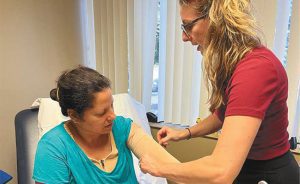
We hear so much about the importance of early detection/mammograms, treatment and participation in events that support research. But lymphedema, a side-effect of breast cancer treatment, affects thousands each year and is not widely known. Lymphedema is swelling in the body due to an obstruction in the lymphatic system, which moves lymph fluid through the body. If lymph nodes or vessels are damaged or removed, the fluid cannot flow out, so it builds up, causing swelling. St. Anthony’s Hospital and many other BayCare facilities offer outpatient treatment for lymphedema and other complications after breast cancer treatment.
Odalmis Ricardo-Perez wishes she had known about lymphedema. When Ricardo-Perez learned that she had breast cancer in 2020, she didn’t hesitate to make a plan with her doctor. She decided to have a double mastectomy – the right breast removed because that’s where the cancer was found and the left removed for preventative measures. Her treatment plan also included chemotherapy and radiation before reconstruction.
During her surgery, several lymph nodes were removed from both sides to make sure the cancer had not spread.
After undergoing chemotherapy and radiation, Ricardo-Perez began to feel some pain and slight swelling around her shoulder, the right arm and in the right breast. She also was having some functional issues with her arm. She told her physician who referred her to receive treatment for a common side effect of the removal of lymph nodes.
“Lymphedema happens quite often for breast cancer patients,’’ said Shelby Green, an outpatient physical therapist at St. Anthony’s campus Resource Center on the St. Anthony’s Hospital in St. Petersburg. Green, a therapist at St. Anthony’s for more than seven years, said that she has helped to ease the pain of lymphedema for hundreds of patients. “So often the patients I see say that they wish they had known this was a possibility of their treatment.,” Green said. “And they wish they could have gotten to me sooner.”
Treating Lymphedema
According to the National Institutes of Health, primary lymphedema is rare, affecting about 1 in 100,000. Breast cancer patients fall into the secondary lymphedema category, which is the most common cause of the disease, the NIH says. It affects about one in 1,000 Americans each year.
Lymphedema can occur anywhere in the body, Green said, not just the arms or legs. “Arm, chest and upper back lymphedema are most common in our breast cancer patients because of the effects on the axillary (relating to the armpit) lymph nodes most commonly treated during their cancer care,” she said.
“We treat our patients with a combination of manual lymph drainage to stimulate and re-route the flow of lymph; compression bandages; garments and pumps. We also use exercises to promote circulation and regain strength and mobility of the affected arm or leg,” said Zoltan Bouwhuis, an outpatient rehab therapist at the BayCare Medical Office (Carillon), who has been treating lymphedema for 25 years. He is one of several certified lymphedema therapists with BayCare. “Besides lymphedema we treat restrictions in shoulder mobility caused by surgery and/or radiation therapy, scar tissue restrictions and restrictions after reconstructive surgery.”
When Ricardo-Perez comes in for her treatment, she discusses her new compression garments with Green. Then Ricardo-Perez lies back on a table as Green uses a light circular touch to move the lymphatic fluid. Green says that helps the fluid to flow as it should if the lymph nodes had not been removed.
Soon, Green has Ricardo-Perez doing several decongestive exercises including using some elastic bands to promote the use of her right arm. Green helps her keep the correct form so that the exercises will be more effective. Ricardo-Perez uses compression sleeves on both her arms and a compression bra to prevent swelling.
“We use gentle pressure over and around the swollen region and focus on re-routing the fluid to healthy areas of the lymphatic system,” Green said. “The decongestive exercises help to promote lymphatic drainage after performing lymph drainage and applying compression garments. The goal is to help the patient regain full mobility in the area affected by the lymphedema.”
‘It Can Happen to You’
For Kurt McDuffie, an Air Force veteran, learning that he had breast cancer was quite a shock. What felt like a mosquito bite on his left breast in 2015 turned out to be a malignant mass. “It was a bump under the skin and it wasn’t going away,” McDuffie said. “When the doctor told me I had breast cancer, I didn’t have any thoughts. I just went blank. I couldn’t think straight.”
According to the Centers for Disease Control and Prevention, about 240,000 cases of breast cancer are diagnosed in women and about 2,100 in men each year.
After his initial reaction, everything else started to happen fast. He had surgery to remove the breast. He also had 18 lymph nodes removed. And then came the follow up treatment of chemotherapy and radiation.
He began to settle back into work a bit after the surgery. One day, a co-worker asked McDuffie what was wrong with his arm. It was swollen. “I had never heard of lymphedema before,” he said.
Like Ricardo-Perez, McDuffie received physical therapy, first with Bouwhuis and then with Green to reduce the swelling. He also wears compression garments – wraps for his arm and for lymphedema in his leg that is not connected to his breast cancer – to control the swelling. He now receives therapy when necessary. “I use compression garments every day,” he said. “If you have a problem, you must work to fix it. This came out of the blue. It can happen to you. But I was glad I was able to get some help for it.”
Bouwhuis, a physical therapist for 33 years with 16 of those at BayCare, said the fact that he began working with McDuffie many years ago points to the long-term challenges that lymphedema can present. But there is good news on the horizon, he said. “Starting in 2024, Medicare will begin paying for compression garments for patients with lymphedema,” Bouwhuis said. “This should help a lot of patients who until now had to pay out of pocket for compression garments.”
Green said that having patients sent sooner for treatment is so important. “We’re able to help them transition from coming to our clinic for treatment to an independent home program,” she said. “They learn how to appropriately manage their lymphedema long-term.”
St. Anthony’s Hospital
BayCare Health System
 Central Florida Health and Wellness Magazine Health and Wellness Articles of the Villages
Central Florida Health and Wellness Magazine Health and Wellness Articles of the Villages


